日英翻訳見本 その(1) デジタル化 ― レトロフィットIoT のページです。
その他の翻訳見本は、以下になります。
日英 → (2) (3) (4) (5) (6) (7) (8) (9) (10) (11) (12)
英日 → (1) (2) (3) (4) (5) (6)
デジタル化 ― レトロフィットIoT
出典: 株式会社 日経BP発行 「日経テクノロジー展望2022 世界を変える100の技術」
<原文>
PDFファイルはこちらから→Click here for a PDF file.
レトロフィットIoT
長年使っている製造機器をITで管理する手法
技術成熱度・・・・・・・高
2030期待度・・・・・7.3
現場で使われている古い工作機械をコンピューターで制御したり稼働状態を記録したりできるようにすること。古い機械や設備を改修して新機能を付加することをレトロフィットと呼ぶがそのデジタル版である。IoT(モノのインターネット)と言ってもインターネットにつながない場合もある。
デジタル技術を取り込んで業務を改革する動きは製造現場にも及んでいるが、古参の製造機械の数々が製造そのものにおいては問題ないものの、コンピューター制御や管理が難しいという実態があった。
山形県鶴岡市でプリント回路基板(PCB)を手掛けるOKIサーキットテクノロジーは2020年度から始めている工場の自動化の一環で、20年以上稼働しているアナログ装置をネットワークに接続し、デジタルデータで生産条件を設定し、品質記録を取れるようにした。
OKIサーキットテクノロジーは10層以上で難易度の高い基板をつくるため、段取り替えの作業も併せて自動化していく。デジタル化の最初の対象になったのは、エッチングエ程ラインと積層工程のホットプレス設備である。ェッチングエ程のラインにワーク(PCBの基材)を投人する際、添付されているカードのバーコードをタッチパネル画面から作業者が読み込ませると、スプレー装置やコンべヤーなど3つの設備に設定値を人力できる。従来は作業者が3カ所の制御盤を渡り歩いて手作業で設定していた。
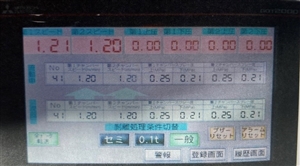
図 タッチパネルによりデジタル化した設定画面
(出所:日経ものづくり、画像は台形補正済み)
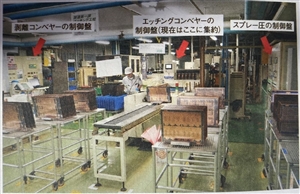
図 工ッチングエ程ラインの制御盤は従来3カ所に分かれていた
(出所:日経ものづくり)
積層工程についてはホットプレス機の制御装置にデータロガーを取り付け、加工時の品質記録をコンピューター上に残すようにした。品質記録のデータを基準値と比べ、大きくずれている場合、警告を出す仕組みを今後導人する。
従来は制御装置についているペンレコーダーがチャート用紙に直接描き、用紙を保管していた。制御装置からペンレコーダーが受け取っていたアナログ信号をデジタル変換した上でデータロガーに渡している。
レトロフィットIoTを狙ったサーピスも登場している。村田製作所とソフト開発などを手掛けるACCESSは2021年2月から、中小製造業が工場設備の状況を簡単にデータで把担一できるサービスJIGlet(ジグレット)を始めた。
設備や機器と組み合わせて使うセンサーデバイスはサイコロ、照度、ボタンの3種類。いすれもLTEを内蔵、電源を入れるだけでクラウドサービスにつながり、デバイスに貼られたQRコードを管理端末に使うタブレットに読み込ませれば使える。
サイコロデバイスは現場の状況を伝える。各面に装置の稼働、部品待ち、トラブル停止といったシールを貼っておき、現場の作業者は特定の面を上に向けることで状況変化を知らせる。
照度デバイスは点灯や消灯を検知して知らせる。生産設備の3色アンドンの緑色灯(正常)に取り付ければ、設備の稼働状況を把握し、集計できる。
ボタンデバイスを押すと、生産現場で検査をする作業者は不良品の発生などを報告できる。現場に置いたタブレットの管理画面に稼働状況をグラフで表示させることも可能である。
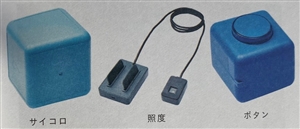
図 センサーデバイス「サイコロ」「照度」「ボタン」
(出所:村田製作所)
サービのアカウント開設費が15万円、デバイスに1個3万円の初期費用がかかる。月額利用料はデバイス1個あたり3500円。
(木崎 健太郎=日経クロステック・日経ものづくり、小林 由美=facet)
<訳文>
PDFファイルはこちらから→Click here for a PDF file.
Retrofit IoT
The method of managing manufacturing equipment that has long been used by means of IT.
Technology maturity level: High
Expectation for 2030: 7.3
A system that uses computers to enable control of old machine tools used on the floor, allow the operating states of them to be recorded, and/or enable other things. An act of modifying an old machine or equipment to add a new function to it is referred to as a retrofit or retrofitting, and retrofit IoT means a system for digitalized retrofitting. IoT is an abbreviation for the Internet of Things, but the system is not always connected to the Internet.
Moves to reform operations by incorporating digital technology are afoot also among those engaged in manufacturing. They faced the reality that many long-used manufacturing machines working properly in terms of manufacturing were difficult to control and manage with computers.
OKI Circuit Technology, a printed circuit board (PCB) provider based in Tsuruoka City, Yamagata Prefecture developed a system to obtain quality records by connecting their analog devices that have worked for more than 20 years to a network and setting production conditions with digital data as part of factory automation they began to work on in the 2020 fiscal year.
For the production of PCBs of ten layers or more with a high degree of difficulty, OKI Circuit Technology will also start automating the changeover work. They started their digitalization with digitalizing the etching process line and hot-pressing equipment in the lamination process. When introducing workpieces (PCB substrates) into the etching process line, an operator can enter the set values into three pieces of equipment including a sprayer and conveyor by scanning the barcode of an attached card from a touch screen. In the past, an operator had to walk across three control panels to make settings manually.
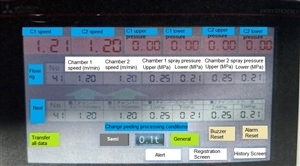
Figure: The settings screen that was digitalized by adopting a touch screen
(Source: Nikkei Monozukuri (Image keystone corrected))
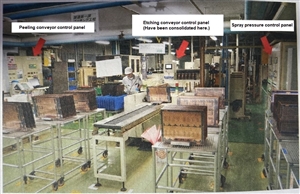
Figure: In the past, the etching process line had control panels in three different locations.
(Source: Nikkei Monozukuri)
With regard to the lamination process, a data logger has been attached to the controller of the hot-pressing equipment so that quality records during the processing are kept on a computer. A mechanism will be introduced to compare the data of the quality records with the reference value, and give an alert when there is a large difference between them.
A pen recorder attached to the controller used to write such data directly on chart forms based on analog signals received from the controller, and the forms were kept. Now the analog signals are converted into digital signals, which are transmitted to the data logger.
Retrofit IoT also offers a market for new services. In February, 2021, Murata Manufacturing launched a service "JIGlet" as a joint business with ACCESS, a firm engaged in software development and other services, to allow small and mid-sized manufacturers to easily grasp the situations of their plants and equipment through data.
The service uses three types of sensor devices, the dice, illumination and button, in combination with facilities and equipment. As each of the devices is equipped with the LTE communication function, turning on the power automatically connects them to the cloud service. The devices can be used simply by scanning the QR code labels on them with a tablet to be used as a management terminal.
The dice device communicates the situation on the floor. Stickers indicating such equipment states as "Operating", "Awaiting parts", and "Downtime" are affixed to the dice faces to allow the operator on the floor to communicate any changes in the situation by putting the dice with a specific face up.
The illumination device detects the turn-on and -off of lights, and communicates them. Mounting this device on the green light of the Andon three-color double-sided lightbox sign (to indicate the normal operation) of the production equipment allows the operating states of the production equipment to be grasped and tabulated.
Inspection operators on the production floor can report any issues such as defective items by pressing the button device. It is also possible to graphically display the operating states on the management screen of the tablet placed on the floor.
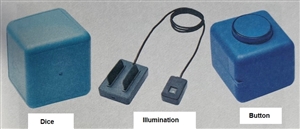
Figure: Sensor devices, "dice", "illumination", and "button"
(Courtesy of Murata Manufacturing)
The service costs 150,000 yen for creation of a new account, and requires an initial cost of 30,000 yen per device. The monthly fee per device is 3,500 yen.
(By Kentaro Kizaki, Nikkei Monozukuri / Nikkei XTech and Yumi Kobayashi, facet)